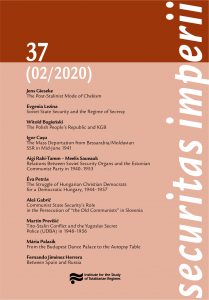Between Spain and Russia: The long shadow of the Soviet Cheka and its use in propaganda in Spain in the 1920s and 1930s as well as during the Spanish Civil War
Between Spain and Russia: The long shadow of the Soviet Cheka and its use in propaganda in Spain in the 1920s and 1930s as well as during the Spanish Civil War
Author(s): Fernando Jiménez HerreraSubject(s): Military history, Political history, Recent History (1900 till today)
Published by: Ústav pro studium totalitních režimů
Keywords: Spanish Civil War; Spanish Revolutionary committees; Revolutionary violence in Spain in 1936; Francoist propaganda; Cheka; Soviet Union;
Summary/Abstract: During the Spanish Civil War (1936–1939), a concept gained great relevance on the rebel side: the term “Cheka”. This concept was used repeatedly by Francoʼs propaganda to define the popular committees that emerged in the Republican rearguard. Throughout this text, the different meanings of the concept are analysed, as is the meaning given to it by the media, mainly the press, to compare both the Spanish revolutionary committees and the Russian Cheka. After studying the Soviet institution in its context – the Russian Civil War – and a compilation of the main news about it during the 1920s and 1930s in Spain (although it was no longer known as Cheka, the concept remained in the press), this essay will proceed to analyse the revolutionary processes of 1936 and the organs that promoted them: the committees. The Francoists established parallels between the Cheka and the committees based on the use of violence. They maintained that the Spanish committees emulated the actions of the Commission, and taking it as an example, they launched the revolution. However, the present investigation attempts to dismantle such a hypothesis. The revolutionary violence of 1936 had nothing to do with the Cheka or its agents in Spain during the civil war. It was a popular reaction to an unexpected situation: the loss of power by the state. The committees exercised the “justice of the people” in the face of mistrust towards the judicial apparatus – classifying it as bourgeois – and under their own guidelines. They were neither guided by a foreign institution nor attempted to emulate one. The 1936 violence in Spain had its own dynamics, as did the violence in Russia between 1917 and 1923. While the committees emerged as an alternative to the state, the Cheka was born under its protection. The governments favoured the Commission, granted it prerogatives as well as extensive legislation and budgets. The committees, on the other hand, had successive governments fight them to regain the monopoly of lost power. They were two different structures, which only had the use of violence in common. So why did they call them “Chekas”? This is the question that guides the following investigation.
Journal: Securitas imperii
- Issue Year: 2020
- Issue No: 37
- Page Range: 186-199
- Page Count: 14
- Language: English

